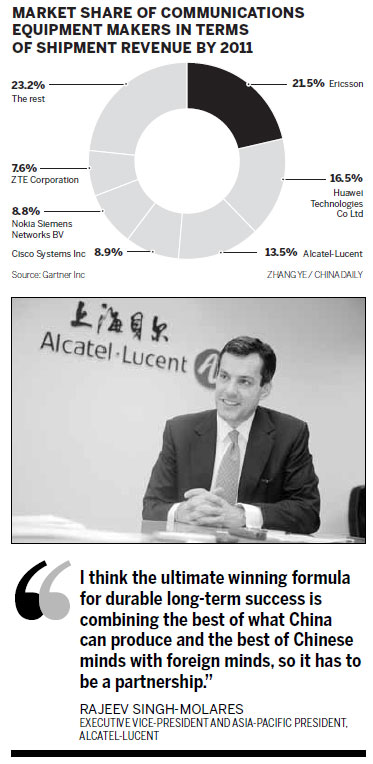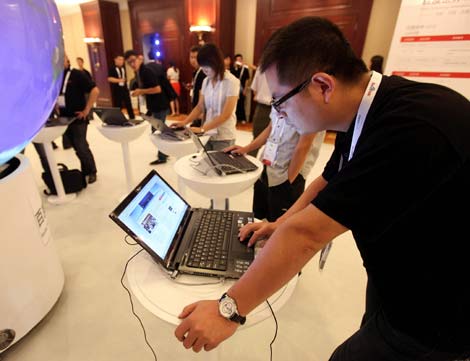
|
 |
|
The Alcatel-Lucent booth at a communications technology exposition in Shanghai. The company's revenue climbed to 15.3 billion euros ($19.53 billion) in 2011, with net income reaching 1.1 billion euros. [Photo / China Daily] |
Narrowing the digital divide is a key task outlined in the United Nations Millennium Development Goals, but Rajeev Singh-Molares believes one can be part of the solution without working for the UN.
Educated at the United Nations International School and majoring in foreign affairs at Yale University and Georgetown University, he could have had the chance to do so.
But "entrepreneurship is not about a business degree; it is about the personality and the traits you have", said the executive vice-president of communications equipment maker Alcatel-Lucent and Asia-Pacific president of the company.
To him, the study of international affairs was coupled with the study of management, where he developed a set of business skills in Yale and joined a bank in New York where he learned the basics of balance sheets.
That landed him with a position in a business consulting firm founded by a Harvard professor, where he worked with more than 100 companies from startups with uncertain business models to established companies with tens of billions of dollars in revenues looking to redefine their models.
So, even though he was not trained as a business professional, he took the helm of Alcatel-Lucent's Asia-Pacific businesses in 2009 with a pressing task: To turn around a company that was struggling in an industry plagued by eroding profits and rising competition from Chinese equipment makers.
Three years ago he settled in Shanghai, a city to which he can't even recall paying his first visit. But he was impressed with the massive infrastructure upgrade across the country and, in terms of the telecommunications industry, with the rapid deployment of fixed broadband networks and the introduction of 3G services.
Although not as prevalent as it is today, Singh-Molares noticed a pickup in smart devices in Asia, an area that is home to countries with both the highest and lowest levels of Internet penetration.

He is also more aware than most of the breakneck speed of this growth in data demand. "There are at least 15 large-scale fiber network rollouts currently being carried out and there are many more that are being planned or are under way."
Buoyed by these devices, the surge in data traffic will continue to accelerate in Asia, which is still lower relative to the United States and Western Europe, he said. "So operators will need to add more capacity in the core network to carry the traffic."
Singh-Molares and his team sensed the opportunities. They defined the turnaround strategy and set out a vision called "application enablement". It is based on the view that, over time, all the networks are going to move to Internet protocol.
To implement the strategy, the company relies on Bell Labs and a global research and development team to develop new products catering to the new trends in domains such as IP, optics, services, access business and passive optical network technologies. Singh-Molares insisted that to ride the telecommunications boom in China it only makes sense for the company's China operation to move up the value chain accordingly. So he became the driving force to turn the China joint venture, Alcatel-Lucent Shanghai Bell, from a manufacturing center to a genuinely international research and development hub.
Unique to Shanghai Bell was the fact that it was co-created two decades ago with the State-owned Assets Supervision and Administration Commission. According to Singh-Molares, they need to balance the commercial realities with the requirements of the government.
As the country plans to invest 1.6 trillion yuan ($254 billion) in broadband network construction by 2015, Singh-Molares said he hopes to unlock the huge potential by answering the government's call and transforming Shanghai Bell into a global innovation center.
"Twenty years ago, Shanghai Bell was simply for assembly and export. We have managed to do some designs here but that is not enough apparently," he said.
Now Shanghai Bell is established in a more balanced pattern. It still serves as a sales port, but increasingly it anchors on R&D from idea forming to co- creation of new products.
Currently, some 6,000 research fellows and engineers work in innovation laboratories in key cities including Shanghai, Beijing, Qingdao, Nanjing and Chengdu. That equals to one-quarter of Alcatel-Lucent's R&D workforce around the globe.
Leveraging on its wide range of portfolios, Singh-Molares secured two landmark contracts in the country. In May, China Telecom Corp selected Alcatel-Lucent for a 100 million euro ($128 million) contract to build a fiber-to-the-home network to deliver high-speed Internet access and video streaming services across the country. Alcatel-Lucent provides the cutting-edge intelligent management system for the project.
The project is a milestone in China Telecom's ambitious Broadband China, Fiber Cities' plan which was launched at the beginning of last year to bring FTTH coverage to 100 million households and 30 million subscribers by 2015.
"This project highlights the rapid expansion of broadband in China. It also demonstrates our strong and growing leadership position in the FTTH market as we help accelerate the availability of super-fast broadband throughout China," he said.
Another deal is to co-create with China Mobile Ltd a broadband base station solution in a smaller and energy-efficient manner.
Singh-Molares said the deployment of 3G and 4G networks will require a lot more base stations in density to ensure receivers a good experience. But one challenge was to get panning permission to place the big, old antennae across cities.
Known as LightRadio, the palm-sized box the company invented eliminates the need for cumbersome huts at the base of cellphone towers and packs antennae that are small enough to fix to a lamppost.
|
 |
|
An international Internet exhibition in Beijing. Global Internet traffic increased eightfold over the previous five years and will increase fourfold in the next five, say experts. [Photo / Bloomberg] |
The company only picked four leading operators worldwide because a larger mass customization would be too expensive. He said they only work with big customers with unique positions in market places - and China Mobile is not just big in China but influential globally with 650 million customers.
Now they have invited a team of 20 China Mobile engineers to work with counterparts at Alcatel-Lucent's lab in Stuttgart, Germany. They are embarking on a cube-based radio baseband unit, pooling and defining the radio architecture. He anticipated the first batch of products can be commercially available by the end of this year.
Alcatel-Lucent ranked third in the highly competitive communications equipment market, having 13.5 percent in terms of global shipment revenue by the end of 2011, said Tian Ying, principal analyst at Gartner Inc.
It is also the world leader in the code division multiple access market by revenue, with a market share of 43.3 percent, according to telecommunications research firm Dell'Oro Group. CDMA is a channel access method used by various radio communication technologies.
In the Asia-Pacific, Alcatel-Lucent competes intensively in access and optical transportation with China's Huawei Technologies Co Ltd, which is No 1 in the region, Tian said.
"Alcatel-Lucent provides almost all the technical products carriers might need, so their advantage would be the whole range of end-to-end solutions they can offer," she said, adding that LightRadio successfully addresses the challenge that 4G base stations will be allocated more densely.
Despite the challenges, "Alcatel-Lucent responds to the dynamics of today's businesses by providing ease of use, automatic agent license increases and by enabling agents or enterprise users the ability to log into the contact center from any phone, either on or off the enterprise campus," according to a report by consulting firm Frost & Sullivan.
As chairman of the World Economic Forum Global Agenda Council on Information and Communications Technology, he works with industry colleagues to address global issues, including the challenges of digital inclusion in emerging economies, expanding broadband coverage and ensuring viable business models.
He said his adolescence at the UN international school helped him learn to cope with diversity, because his classmates were from more than 60 countries. That is the one thing that matters for success in business in the dynamic world, he noted. "The more international the people are, meaning the more exposure they have received, the better they can understand cultural differences and problems specific to the region. As we move to a global world, the more effective these qualities will be."
Singh-Molares has worked extensively with Asia-based clients and has a deep understanding of the region, their unique growth challenges and the cultural context within which they operate.
So it is perhaps easier for him to understand the urgency of upgrading broadband infrastructure in places such as Mumbai and Bangkok, where jumbles of cable and antennae hang over the streets.
His concern for Asia drove him to rush to Tokyo after the 2011 tsunami and to Bangkok during last year's floods to check on his facilities and teams, even though many people were moving in the opposite direction.
Singh-Molares' attentive efforts are beginning to pay off. The company made a full-year profit last year, the first since the merger of Paris-based Alcatel SA and Lucent Technologies, based in Murray Hill, New Jersey, in 2006.
Revenue climbed to 15.3 billion euros ($19.4 billion). Net income reached 1.1 billion euros. The company had suffered a loss of 334 million euros just a year previously.
Singh-Molares is optimistic about the prospects in China and committed to continued investment. "China's Five-Year Plan (2011-15) is very clear. It now needs to move from basic advantages based on labor costs to create value-added elements. So, in our industry, it's about broadband infrastructure. We are part of the SASAC family and have been doing business in China for more than 25 years. So it is very reasonable for us to believe that the growth will continue significantly."
Singh-Molares is also looking beyond China. Shanghai Bell has developed customized e-governance products for the Fiji government.
"I think the ultimate winning formula for durable long-term success is combining the best of what China can produce and the best of Chinese minds with foreign minds, so it has to be a partnership," he said.
hewei@chinadaily.com.cn